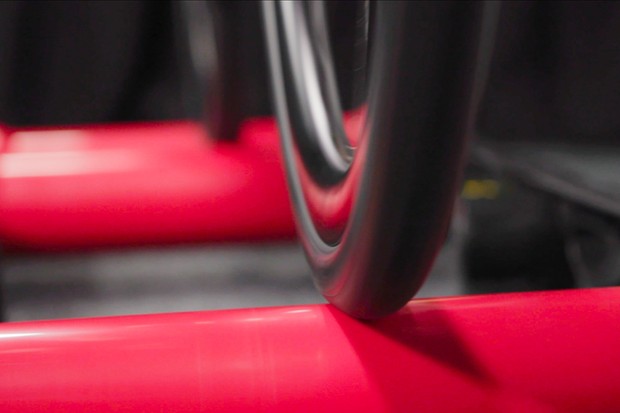Tyre width: The Great Debate in Road Cycling
Among road cyclists, the width of tyres has sparked intense discussions and varying opinions. Traditionally, narrow tyres (measuring 23mm or less) were favored due to their assumed lighter weight, which was believed to result in greater speed.
However, a shift in the consensus has emerged recently, as manufacturers now advocate for the use of wider tyres (28mm or larger). They claim that wider tyres offer superior rolling resistance and a more comfortable ride quality.
Now, the question arises: What is the optimal tyre width for road cycling? In order to answer the inquiry of whether wider tyres are indeed faster, we conducted two tests, utilizing the acclaimed Pirelli P-Zero Race TLR tyre in two different sizes: 700×26mm and 700×30mm.
These particular tyre widths were selected to represent the traditional, narrower road bike tyre width, as well as encompassing what many road cyclists consider to be a relatively wide tyre.

Road bike tyres have progressively increased in width over the years, but the crucial question remains: Are wider tyres genuinely faster? To find out, we conducted a comprehensive examination. Russell Burton / Immediate Media
The initial test was conducted indoors using rollers, while the second test took place outdoors, encompassing diverse road conditions.
The indoor testing aimed to provide precise data on any disparities in rolling resistance between the narrower and wider tyres. However, it is equally essential to evaluate the pros and cons of each tyre set in real-world scenarios, leading us to the second test. Ultimately, most of us ride our bikes in the real world, not just on virtual rollers.
Based on our experience, finding the ideal road bike tyre width involves striking a balance between comfort, rolling resistance, and aerodynamics.
In this head-to-head comparison, we assessed two popular tyre widths: 26mm and 30mm. Russell Burton / Immediate Media

For instance, wider tyres may offer enhanced comfort, but utilizing them may mean sacrificing a marginal degree of aerodynamic efficiency.
Where the balance lies for you will depend on your road bike and riding style, but we have some recommendations to help you choose the best tyre width that suits your needs.
Choosing the Best Tyre Width for Your Road Bike
Once you’ve finished reading this, don’t forget to check out our guide to the best road bike tyres. We also have a buyer’s guide to the best tubeless tyres. If you’re considering ditching your inner tubes, here’s everything you need to know about tubeless setup.
Indoor Roller Testing: Finding the Right Tyre Width
Indoor roller testing allows us to isolate the specific variables we want to test in a more controlled environment, compared to the unpredictable real world.
Part 01: Testing the Impact of Tyre Width
The test protocol is straightforward. We take two sets of identical tyres with different widths and ride on rollers at a fixed speed for a fixed time interval. We then record the power required to maintain that speed.
All other variables, such as the bike, wheelset, tyre type, and riding position, remain the same for each run. The tyre pressure is also consistent, with both the 26mm and 30mm tyres inflated to 90psi / 6.2bar.
If one tyre width requires less power output to maintain the target speed, we can conclude that it has lower rolling resistance.
During the test, the target speed was set at 40kph, and each interval lasted for 5 minutes.
Before starting each interval, a 5-minute warm-up was performed to bring all elements of the system to a consistent operating temperature, aiming for an average speed of 40kph.
Each run was repeated twice, and the results were averaged to ensure consistency.
It’s important to note that this test doesn’t perfectly replicate real-world riding conditions. The roller surface is smoother than any road, and the tyre deformations are slightly different. However, it still provides a controlled way to measure the effects of changing specific variables, such as tyre width.
Riding on Rollers: Testing Tyre Rolling Resistance
Roller testing allows us to measure the power required to ride at a target speed, giving us valuable insights into tyre rolling resistance.

All test runs were performed on a Giant TCR Advanced Pro 2 Disc road bike with a FFWD F3AD clincher wheelset.
Tyre Width and Testing: Pirelli P-Zero Race TLR
As mentioned earlier, the tyre model used for our testing was the Pirelli P-Zero Race TLR, available in sizes 700×26mm and 700×30mm. Both tyre variants share the same construction and rubber compound, with the only distinction being their width.
Although the tyres are tubeless-ready, we decided to test them with butyl inner tubes for the sake of convenience when swapping between different tyre sets. This choice, however, introduced a small amount of rolling resistance to the wheel and tyre system for both width options, as compared to setting them up tubeless. Nevertheless, this decision did not impact any relative differences between the two tyre widths.
To measure power, we employed a pair of Favero Assioma Duo power meter pedals, which were appropriately calibrated at the beginning of our testing.
Results: Narrow vs Wide Tyres
Our roller testing at a speed of 40kph revealed that the 30mm tyres required an average power output of 152 watts, while the narrower 26mm tyres demanded 166 watts. This variation resulted in a difference of 14 watts.
So, are wider tyres drastically faster than their narrow counterparts? Provided we disregard aerodynamics and assume an equal pressure on a perfectly smooth surface, the answer is a resounding yes.
This is due to the fact that, at identical pressure levels, wider tyres exhibit higher casing tension and a shorter, wider contact patch. The increased casing tension results in less energy loss due to casing flex, while the broader contact patch reduces rolling resistance by minimizing frictional losses.
However, is the matter truly settled? Not quite. We are overlooking a crucial aspect at this stage – the practical use of wider tyres. Tyre pressure is a significant factor that we must consider.
| Run 01 | Run 02 | Run 03 | Run 04 | |
|---|---|---|---|---|
| Wheelset | FFWD F3AD | FFWD F3AD | FFWD F3AD | FFWD F3AD |
| Tyre model | Pirelli P-Zero Race TLR | Pirelli P-Zero Race TLR | Pirelli P-Zero Race TLR | Pirelli P-Zero Race TLR |
| Tyre size | 700x30mm | 700x30mm | 700x26mm | 700x26mm |
| Target speed | 40kph | 40kph | 40kph | 40kph |
| Warm up time | 00:05:00 | 00:05:00 | 00:05:00 | 00:05:00 |
| Lap time | 00:05:00 | 00:05:00 | 00:05:00 | 00:05:00 |
| Tyre pressure (psi/bar) | 90 / 6.2 | 90 / 6.2 | 90 / 6.2 | 90 / 6.2 |
| Lap avg power (watts) | 153 | 151 | 167 | 165 |
| Lap distance (km) | 3.34 | 3.34 | 3.33 | 3.35 |
| Lap avg speed (kph) | 40.1 | 40.1 | 40 | 40.2 |
| Results | ||||
| Tyre size | 700x30mm | 700x26mm | Difference | |
| Avg power at equal pressure (watts) | 152 | 166 | 14 |
Indoor Roller Testing Part 02: Tyre Width and Tyre Pressure
In real-world scenarios, when employing wider tyres, we typically do not inflate them to the same pressure as we would narrower ones.
Doing so would lead to greater casing tension in the wider tyre, rendering it stiffer and less comfortable compared to its narrower counterpart.
For instance, a 30mm tyre inflated to 90psi / 6.2bar would certainly be extremely stiff. The purpose of opting for wider tyres is to gain enhanced comfort, which in turn may be compromised if the tyre pressure is too high.
On perfectly smooth surfaces like rollers or velodromes, higher tyre pressures and casing tensions minimize rolling resistance by reducing energy loss due to casing flex and decreasing the size of the contact patch.
However, things are not quite as straightforward in the real world. Roads are not as smooth as rollers. Therefore, wider tyres should be inflated to lower pressures than narrower ones to allow for casing flex and absorption of imperfections in the road surface. Over-inflating tyres would result in the bike bouncing over these imperfections, ultimately leading to decreased grip and speed.
| Run 05 | Run 06 | Run 07 | Run 08 | |
|---|---|---|---|---|
| Wheelset | FFWD F3AD | FFWD F3AD | FFWD F3AD | FFWD F3AD |
| Tyre model | Pirelli P-Zero Race TLR | Pirelli P-Zero Race TLR | Pirelli P-Zero Race TLR | Pirelli P-Zero Race TLR |
| Tyre size | 700x26c | 700x26c | 700x30c | 700x30c |
| Target speed | 40kph | 40kph | 40kph | 40kph |
| Warm up time | 00:05:00 | 00:05:00 | 00:05:00 | 00:05:00 |
| Lap time | 00:05:00 | 00:05:00 | 00:05:00 | 00:05:00 |
| Tyre pressure (psi/bar) | 83 / 5.7 | 83 / 5.7 | 65 / 4.5 | 65 / 4.5 |
| Lap avg power (watts) | 165 | 165 | 170 | 170 |
| Lap distance (km) | 3.34 | 3.34 | 3.33 | 3.33 |
| Lap avg speed (kph) | 40.1 | 40 | 40 | 40 |
| Results | ||||
| Tyre size | 700x30mm | 700x26mm | Difference | |
| Avg power at real world pressure (watts) | 170 | 165 | -5 |
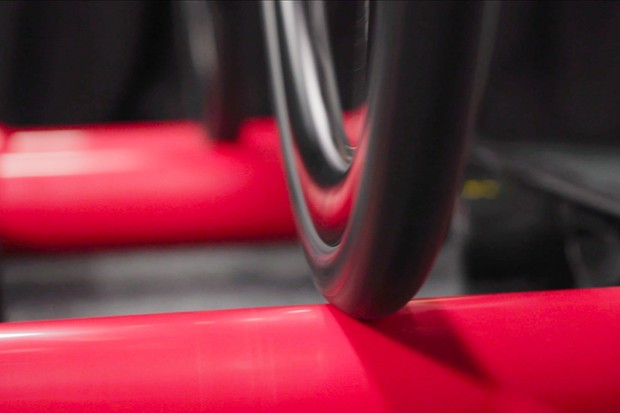
The Importance of Tyre Pressure and Size in Roller Testing
In the second part of the roller testing, we made adjustments to the tyre pressure based on the size of the tyres. This meant that wider tyres required lower inflation pressure, while narrower tyres needed higher pressure.
By doing this, not only were we able to achieve more accurate representations of real-world usage conditions, but we were also able to negate any advantage in rolling resistance that may arise from increased tension on the wider tyres.
According to Pirelli’s recommendations, considering my weight of approximately 64kg, I should be running the 26mm tyres at 83psi / 5.72bar and the 30mm tyres at 65psi / 4.48bar. Therefore, we tested the tyres at these pressures during this phase of the test.
Results:
When riding at the recommended pressures, we found that using the 30mm tyres on the rollers required an average power output of 170 watts, whereas the 26mm tyres only required 165 watts.
Surprisingly, it appears that the tables have turned, and the 26mm tyres now exhibit a 5-watt advantage. It is important to note, however, that these results were obtained under ideal conditions without considering aerodynamics or surface roughness.
So, why is the narrower tyre seemingly offering less rolling resistance than the wider tyres? Once again, the answer lies in casing tension and how tyre pressure affects the size and shape of the contact patch.
When inflated to 83psi / 5.72bar, the 26mm tyre exhibits noticeable stiffness compared to the 30mm tyre at 65psi / 4.48bar. As a result, there is less flex in the casing and a smaller contact patch with the rollers.
Conversely, the 30mm tyres compress more under the weight of the bike and my body, leading to increased losses from casing flex and a larger contact patch.
If we were to precisely adjust the tyre pressure for each tyre size to achieve the same casing tension or stiffness, the rolling resistance would likely be identical.
Conclusions from Roller Testing
Ultimately, our roller testing demonstrates that wider tyres indeed offer less rolling resistance than narrower ones when pressures are equal.
However, when we consider the real-world riding pressures, this advantage disappears.
Real-world riding is a crucial factor to consider as it reflects the actual conditions in which we use our bikes. Therefore, let’s delve deeper into the various factors at play and how they may influence the choice of tyre width for your bike.
The Role of Tyre Width in Real-World Riding
Most cyclists primarily ride their bikes outdoors on actual roads, so it is evident that roller tests alone cannot provide a comprehensive understanding.
Although there may not be significant differences in performance between narrow and wide tyres on rollers, experience teaches us that wider tyres can enhance comfort and performance on imperfect road surfaces by reducing losses caused by a stiff tyre bouncing over irregularities.
Suspension and Grip in Real-World Conditions
In the real world, road bike tyres must serve as suspension systems, absorbing rather than bouncing over imperfections on the road. This capability ensures maximum speed, comfort, and grip by maintaining contact between the rubber and the ground.
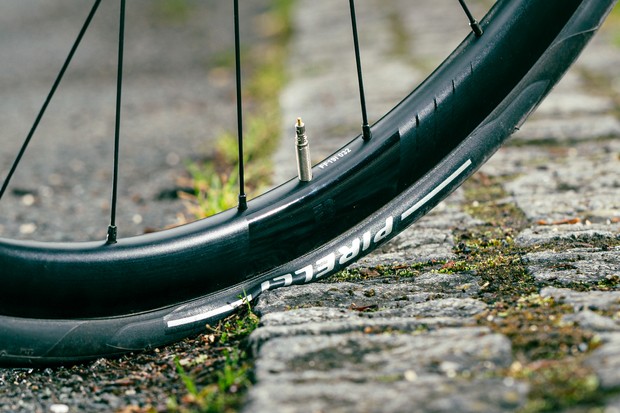
To achieve this, tyre pressures should be lowered as road conditions worsen. However, on extremely rough roads, using tyres that are too narrow may not provide sufficient volume to absorb large bumps and prevent the tyre from bottoming out.
In situations such as hitting a pothole, for instance, the tyre can be squeezed between the rim and the obstacle, which can lead to damage to the tyre, rim, and inner tubes if they are being used.
Therefore, it is essential to consider both tyre pressure and width to optimize performance and safety in real-world riding scenarios.
Tyre Size and Weight
If your tyre doesn’t have sufficient volume or isn’t inflated correctly, you run the risk of bottoming it out when encountering large obstacles like cobblestones or potholes. This issue can be particularly problematic for heavier riders and bikes, as they exert greater downward pressure on their tyres. Therefore, Pirelli recommends that riders weighing over 96kg or carrying heavy loads should avoid using tyres smaller than 700×25mm.
Aerodynamics and Tyre Width
On the other hand, when riding on smooth surfaces that require less suspension, a narrower tyre may offer a slight aerodynamic advantage due to a small reduction in frontal area. It’s important to note that many modern aerodynamic road bike wheels are optimized for 25mm tyres, achieving their lowest aerodynamic drag. To ensure compatibility, it is advisable to check the recommended tyre size for your specific wheelset’s design.
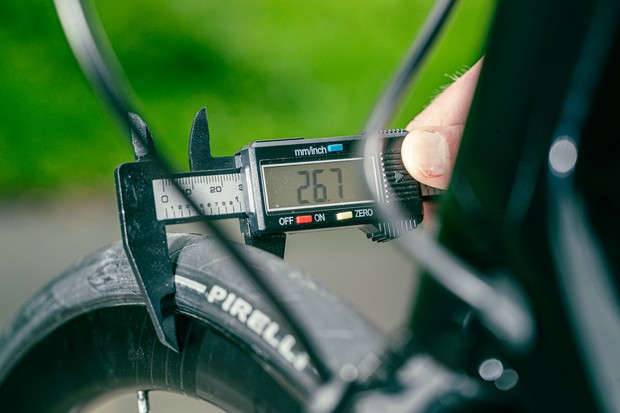
Aerodynamic wheelsets are typically engineered to perform best with tyres slightly narrower than their external rim width. As a general guideline, the external rim width of the wheelset should be slightly wider than the tyres. This consideration is mostly relevant for athletes participating in time trials or road races on well-maintained roads.
Conclusion
Choosing the appropriate tyre size depends on factors such as weight, road conditions, and desired aerodynamic performance. It is essential to strike a balance between volume, inflation, and aerodynamics to optimize your riding experience. By considering these factors, you can enhance your performance while maintaining a smooth and efficient ride.
Overall, the key is to discover a tire size that achieves a harmonious combination of suspension, traction, and aerodynamics.
If you find yourself riding on bumpy roads at slower speeds, your focus should be on suspension and traction. In this case, opting for wider tires would be advantageous. On the other hand, if you’re riding on smooth roads at high speeds, the slight aerodynamic advantage of narrower tires may be worth considering.
Impressions from Real-world Rides
Although roller data provides insight into the variances in rolling resistance between tires within a controlled setting, it is the performance on actual roads that truly matters for most individuals.
To attain a more subjective perspective, we conducted tests on two different tire sizes along a brief 2.7km looped course just south of Bristol. This route encompassed diverse road surfaces.

This particular course conveniently encompasses a freshly paved ascent, a descent on a typical UK road with cracks and imperfections, and a short flat segment in between that contains sections of severely damaged pavement.
In reality, roads are usually not as smooth as rollers. Russell Burton / Immediate MediaFor this experiment, I utilized the recommended tire pressures, as advised by Pirelli, specific to my weight. For the 26mm tires, the pressure was set at 83psi / 5.72bar, while for the 30mm tires, it was 65psi / 4.48bar.
While it would have been possible to collect data via timed laps ridden at a consistent average power, this particular test was conducted on open roads. Therefore, it would have been extremely challenging to eliminate the influence of rider and environmental variables.
Factors such as wind speed and direction, passing traffic, as well as differences arising from braking and line selection during each run, would all introduce noise into the data and result in a substantial margin of error.
Consequently, this experiment focused less on data gathering and more on experiencing the actual feel of riding each tire width consecutively in real-world scenarios.
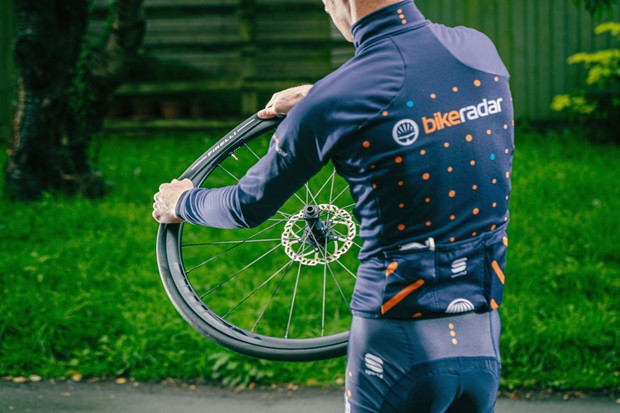
Conclusions from Real-world Rides
Our testing encompassed both roller sessions and road rides. Russell Burton / Immediate MediaAs anticipated, the disparities between the two tire widths on smooth tarmac were negligible.
Effect of Wider Tyres on Comfort and Grip
On well-maintained roads, the wider 700×30mm tyres showed minimal improvement in comfort compared to the 700×26mm tyres. However, we did observe a slight aerodynamic penalty.
As the road conditions became rougher, the advantages of wider tyres in terms of comfort and grip became much more pronounced, almost instantly noticeable.
Even on the supposedly normal roads in the UK, the wider tyres provided noticeably superior comfort, even during a short test ride. Furthermore, whenever the road surface deteriorated significantly, the enhanced grip of wider tyres instilled far greater confidence in the rider.
Enhanced Control and Comfort on Challenging Surfaces
Wider tyres make cornering on gravelly or broken roads feel significantly easier. Descents, in particular, benefit from the larger tyre size as it provides a heightened sense of control.

It is important to keep in mind that while narrow tyres may seem faster on rough roads, the high-frequency vibrations experienced due to the bike bouncing over road imperfections can be deceptive.
As explained in our road bike tyre pressure guide, wider tyres, when set at lower pressures, ensure better contact between the rubber and the road surface, resulting in reduced rolling resistance.
Factors Influencing Tyre Speed
Determining the speed of a tyre is a complex matter, with rolling resistance being a major consideration. The construction and rubber compound of the tyre, assuming it is inflated to the optimum pressure, largely contribute to its rolling resistance.
In general, lighter tyres with thin and flexible casings, along with rubber compounds designed for low rolling resistance, tend to offer greater speed compared to heavier tyres with rigid casings and added features like puncture protection belts. This distinction can be likened to the disparity between summer tyres and winter tyres.
Finding the Balance Between Speed and Durability
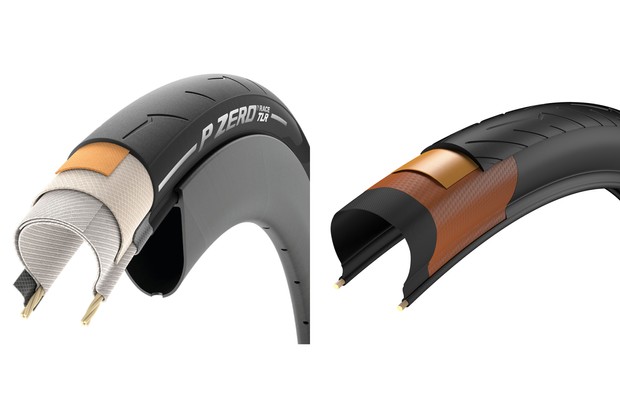
It is worth noting that speed and durability in road bike tyres usually involve a trade-off. The ideal balance depends on the type of riding one engages in. For each cyclist, the optimal combination of attributes will differ.
Paper-thin, lightweight tyres are fantastic for time trial racing on pristine roads. However, they may not withstand an impromptu adventure on your local gravel trail or lengthy days spent on a winter club ride.
What is the ideal tyre size?
Our rigorous testing on rollers reveals that wider tyres offer an advantage in terms of rolling resistance when compared to narrower ones at equal pressures. However, once you account for real-world riding pressures, this advantage fades away.
In reality, the question of whether wider tyres are faster has a more complex answer. While wider tyres do not generate less rolling resistance than narrower ones when taking casing tension into consideration, they should not roll any slower either.
Wider tyres are also more likely to offer greater comfort and enhanced grip. A ride that inspires confidence and provides comfort could ultimately be faster, depending on the terrain. Additionally, it is undeniably more enjoyable.
Therefore, we can choose our tyre width based on other factors such as suspension needs, grip, and aerodynamics. Ultimately, it is essential to consider what you aim to achieve with your bike setup.
We believe that 28mm tyres strike a perfect balance between the important characteristics for most road cyclists in the UK (or if the roads in your area are often rough). Russell Burton / Immediate MediaIf your bike has sufficient clearance, we typically recommend 28mm tyres as they offer a harmonious combination of these characteristics for the majority of UK-based riders. This recommendation also applies if, like us, you reside in a location with less-than-ideal tarmac. Furthermore, if you have wheels with a modern, wide rim profile, there may not be a significant aerodynamic penalty either.
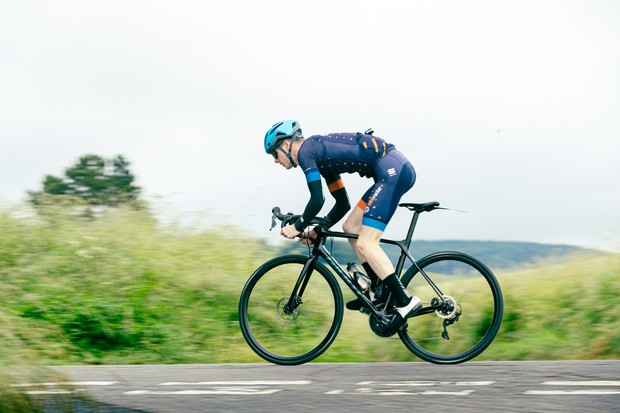
If you participate in races or time trials on well-maintained roads, opting for slightly narrower 25mm tyres may provide a small aerodynamic advantage at high speeds. However, if you are racing on uneven roads, choosing a slightly wider tyre is likely worth the minor aero penalty.
If you frequently ride on exceptionally rough roads or desire to explore some gentle gravel sectors, opting for 30mm (or larger) tyres will most likely offer you greater comfort, superior grip, and improved control off-road without negatively impacting rolling resistance.


